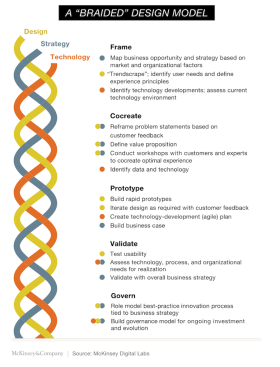Think of the upcoming Builder 100 event–May 11-13, Ritz Carlton Laguna Niguel–as a two-and-a-half-day Spring Training for home building enterprise executives in business’s powerful new strategic practice, design thinking.
Here’s what that means and why that matters for the present and future leadership of America’s most prolific home construction firms. Register now.
To get started, make pictures, diagrams, if you will.
Map the key milestones of a new home’s building lifecycle, from start to completion, starting with site work and foundation, and wrapping up with the interior finishes, landscaping, and walk-through.
It’s nine or 10 steps at least, give or take, no?
Now, map the decision- and skill-set flows that extend out, both before and after that building lifecycle–the land acquisition and planning, the finance, the architecture, the horizontal infrastructure development, etc. leading up to the start, and the sales, marketing, mortgage finance, customer care, closing, community programming, etc., afterwards.
It’s engineering, architecture, land planning, legal, logistics, sourcing, project management, financial analysis, materials science, capital investment, waste management, environmental analysis, data, energy performance, community relations, retail, consumer insight, customer care, municipal policy, code compliance, mortgage lending, warranty work, and at every turn, negotiation, communications flow, optimization, efficiency, margin management.
All of this, so that 250,000 sub-components can add up to a 2,000ish-square-foot conditioned-space win-win value proposition to both buyer and seller. The value to the seller, sustainable profit. The value to the buyer, safety, a sense of belonging, the capacity to prosper and enjoy well-being.
A lot of moving parts. A lot of hand-offs. In a sense, every new home built is an unlikely outcome of dozens of disparate–often countervailing–projects.
Which is why the home building business, and relative success in it, is so drawn to muscle memory. Muscle memory, or another way of putting it, second-nature, has been home building’s way to get 30 to 40 relatively different, separate, discrete, and at times, conflicting stakeholder interests to pull in the same direction, align, and get the job done.
When complex processes involving a dynamic flow of separately-motivated forces–owners of sub-processes–go by rote memory, they can be counted on to succeed, or at least come close.
In manufacturing, variation is the enemy of efficiency. In home building, variations come with the turf–and it’s generally a team that fluently draws on muscle memory that achieves home building’s proxy for true productivity gain.
Now, consider this evidence-based statement:
According to the Design Management Institute’s Design Value Index, for example, design-driven companies have maintained a significant stock-market advantage, outperforming the S&P 500 by an extraordinary 219 percent over the past ten years.
This statement comes from McKinsey & New York digital VP Jennifer Kilian, citing Jeneanne Rae, “Good design drives shareholder value,” Design Management Institute, May 2015, dmi.org.
Now, McKinsey’s Jennifer Kilian spent more than two years gathering data points from several hundred companies that excel at design, and distinguish themselves at understanding the needs of the customer. Kilian will be with us at Builder 100, and she’ll help home building company executive leaders both recognize the value of a design-driven culture, and break it down into four doable elements.
- Really understanding the customer
- Bringing empathy to the organization
- Designing in real time
- Acting quickly

Home building enterprise executives have a tougher challenge with respect to design thinking: it’s not simply how something–the floorplan and elevation–looks. It’s how it comes into being, and how it works, and how it integrates learning into its processes. The other challenge for builders is their reflexive instinct to select muscle memory over all other options when it comes to business and operational processes. But here’s a look at how design thinking validates and aligns the value of both received knowledge and brand new learning into a best practice.
“We’ll try to look in new ways at the most basic question, and frame it from a design thinking mentality,” says Kilian. “Who are we building for and what are their needs?”
Kilian notes that, for customers, the substance of what they get when they buy something and the experience of both being on the purchase journey and owning it have become fused and inseparable.
If you look at most of the best companies in the home building business right now, it would be safe to assume that one of the leading reasons for their outsized performance success and sustained viability traces back to muscle memory.
The “this-time-things-are-different” assumption we’re pushing as a challenge to all successful builders is that consumers/customers themselves have pivoted across an inflection point in how they act on what they prefer, what they value. Kilian says:
“Customers increasingly expect products and services that are designed to meet their needs, delight them with unexpectedly great experiences, and address a heightened sense of aesthetics. Companies that meet those needs are rewarded with fierce brand loyalty and higher spending, which translates into fatter profit margins. But that kind of success only happens by design.”
For so long, it’s been variation, customization, unique job site circumstances, weather interruption, local environmental issues, and of host of other sources of one-off adjustments and course corrections that have been the enemy of a sustainably profitable process to go vertical on a site.
Muscle memory has been one of the few, consistently effective offsets to the pain and cost of such anomalies and variations.
Today, though, customers themselves are driving a change.
Muscle memory is a liability.
When it comes to choosing, pick design versus default.
Join us–and Jennifer Kilian as well as a host of other thought and practice leaders–as we connect the dots between the theories of design thinking and how that works in the very real world of home building enterprise strategy.

